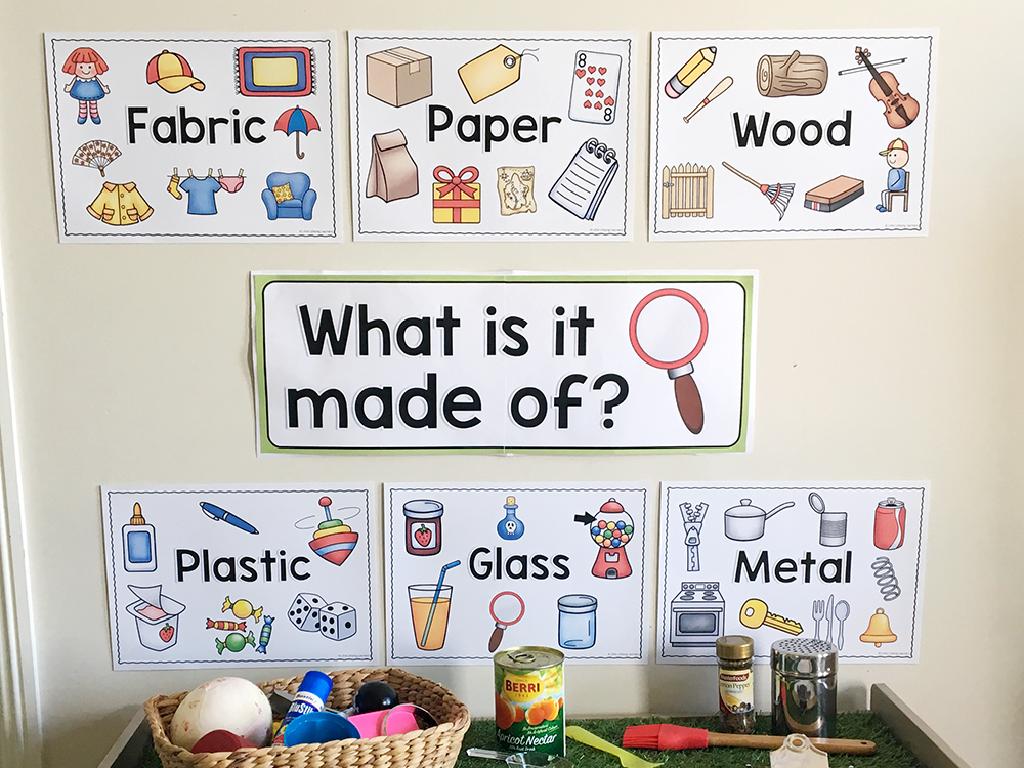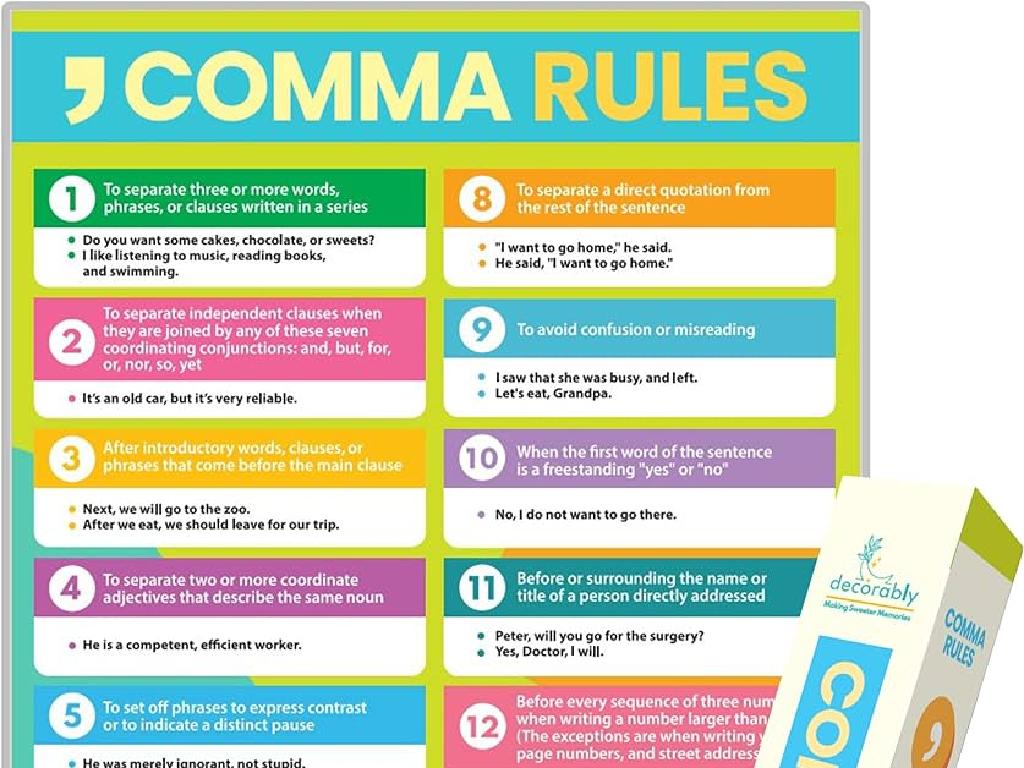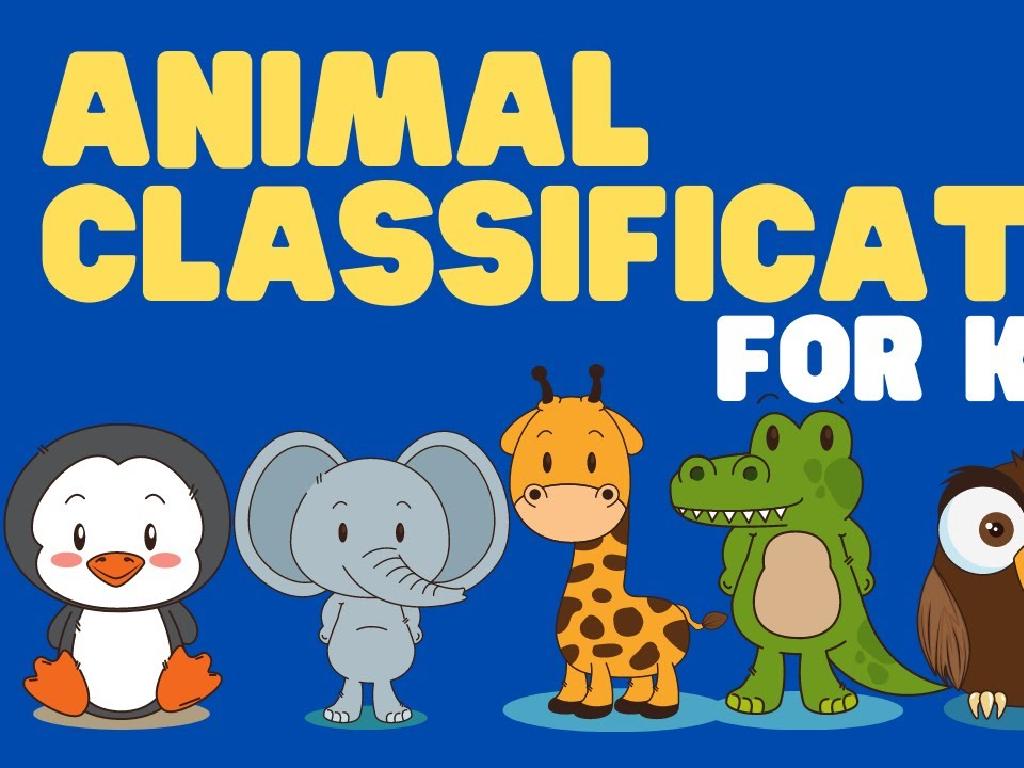Combine Sentences: Subjects
Subject: Language arts
Grade: Second grade
Topic: Sentence Variety
Please LOG IN to download the presentation. Access is available to registered users only.
View More Content
Combining Subjects in Sentences
– Learning to combine sentences
– Combining subjects made easy
– Instead of ‘Sara feeds the cat. Tom feeds the dog.’, say ‘Sara and Tom feed the pets.’
– Why combine sentences?
– It makes our writing more interesting and less repetitive.
– Practice makes perfect
– We’ll do fun activities to get better at it!
|
Today’s lesson introduces the concept of sentence variety through combining subjects. This skill helps students write more fluidly and avoid repetitive sentences. Start by explaining that sentences with the same action but different subjects can be combined by linking the subjects with ‘and’ or ‘or’. Emphasize the importance of sentence variety in making writing more engaging. Provide clear examples, and then let students practice with exercises where they combine subjects from multiple sentences into one. Encourage creativity and provide positive feedback to build their confidence.
Understanding Subjects in Sentences
– What is a sentence subject?
– It’s who or what the sentence is about.
– Examples of sentence subjects
– ‘The cat’, ‘My friends’, ‘The car’.
– Identifying subjects together
– We’ll look at sentences and find the subjects.
– Practice finding subjects
|
This slide introduces the concept of the subject in a sentence, which is fundamental for understanding sentence structure. The subject is typically a noun or pronoun that tells us who or what the sentence is about. Use simple and relatable examples to illustrate subjects, such as ‘The cat’, ‘My friends’, and ‘The car’. Engage the class by working through example sentences together to identify the subjects. This interactive approach helps reinforce the concept. For practice, encourage students to find subjects in sentences from their favorite books or in sentences they create themselves. This activity will help solidify their understanding and prepare them for more complex sentence structures.
Creating Simple Sentences
– What is a simple sentence?
– A sentence with just one complete thought.
– One subject and one predicate
– Subject is who or what the sentence is about; predicate tells what the subject does.
– Example: ‘The dog barks.’
– ‘The dog’ is the subject, ‘barks’ is the predicate.
– Let’s make our own sentences!
|
This slide introduces the concept of simple sentences to second graders. Begin by explaining that a simple sentence expresses a single complete thought and consists of a subject and a predicate. The subject is the person, place, thing, or idea that the sentence is about, and the predicate explains what the subject is doing. Use the example ‘The dog barks.’ to illustrate this point. After explaining, engage the students by asking them to come up with their own simple sentences. Encourage creativity and provide guidance to ensure they grasp the concept of subject and predicate. This activity will help them understand sentence structure and improve their writing skills.
Combining Subjects in Sentences
– Combine two subjects with the same action
– When two subjects do the same thing, we can join them with ‘and’.
– Example: ‘The dog and the cat play in the yard.’
– ‘The dog plays. The cat plays.’ becomes ‘The dog and the cat play.’
– Practice combining subjects together
– We’ll do fun exercises to learn this!
|
This slide introduces the concept of combining subjects in a sentence for second graders. Start by explaining that when two different subjects are doing the same action, we can put them together in one sentence using the word ‘and’. Use simple, relatable examples like the one provided to illustrate this point. After explaining the concept, engage the students with interactive activities where they can practice combining subjects. For example, give them sentences with separate subjects and ask them to combine them, or provide a list of subjects and actions and let them create their own sentences. This activity will help reinforce their understanding of sentence structure and improve their writing skills.
Why Combine Sentences?
– Makes writing interesting
– Combining sentences adds variety, making stories fun to read!
– Avoids word repetition
– Instead of ‘The dog ran. The dog barked.’, we can say ‘The dog ran and barked.’
– Examples show improvement
– ‘Sally loves painting. Sally painted a sun.’ becomes ‘Sally loves painting and painted a sun.’
|
This slide aims to teach students the importance of combining sentences to enhance their writing. By merging sentences, they can create a more engaging and fluid reading experience. It’s crucial to demonstrate how combining sentences can prevent the monotony of repeating the same words or phrases. Use clear examples to show the transformation from simple, repetitive sentences to more complex and interesting ones. Encourage students to think of their own sentences to combine as a class activity, fostering creativity and application of the concept.
Let’s Practice Combining Sentences!
– I’ll give you two simple sentences
– Combine them with one subject
– Find the subject that is the same in both sentences
– Make one good sentence
– Use words like ‘and’ or ‘or’ to connect the ideas
– Raise your hand for help
|
This slide is for a class activity aimed at teaching second graders how to combine two sentences with a shared subject into one cohesive sentence. Start by explaining that a subject is who or what the sentence is about. Then, provide examples of simple sentences that can be combined. Encourage students to look for subjects that appear in both sentences and think about how they can connect them using conjunctions like ‘and’ or ‘or’. For example, ‘The dog barked. The dog ran.’ can be combined to ‘The dog barked and ran.’ Walk around the classroom to assist students who raise their hands and offer guidance. After the activity, have students share their sentences to reinforce the concept.
Class Activity: Sentence Creators
– Pair up and write 5 simple sentences
– Find sentences with the same subject
– Look for sentences about the same person, animal, or thing
– Combine them into one sentence
– Use words like ‘and’, ‘or’, ‘but’ to connect your sentences
– Get ready to share with the class
|
This activity is designed to help students understand how to create sentence variety by combining sentences with a shared subject. By working in pairs, they will practice collaboration and enhance their sentence construction skills. Encourage them to think creatively and come up with sentences that can logically be combined. Remind them to use conjunctions to connect their ideas smoothly. At the end of the activity, each pair will have the opportunity to present their combined sentences, fostering a sense of accomplishment and public speaking skills.
Fantastic Work on Combining Subjects!
– Celebrate your sentence combining
– Combining subjects adds excitement
– It makes sentences more interesting and less repetitive
– Keep practicing at home
– Reading and writing enhances skills
– The more you read and write, the better you’ll get at combining sentences
|
Today’s lesson was all about combining subjects to create more engaging sentences. Reinforce the idea that by combining subjects, students can make their writing more dynamic and less monotonous. Encourage them to continue practicing this skill outside of the classroom by reading books and writing stories or journal entries at home. This will help them recognize sentence structures in literature and apply them to their own writing. Remember to praise their efforts and progress to build their confidence in their writing abilities.






